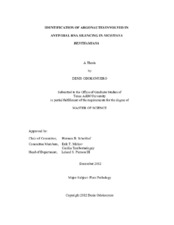| dc.contributor.advisor | Scholthof, Herman B | |
| dc.creator | Odokonyero, Denis 1984- | |
| dc.date.accessioned | 2013-03-14T16:17:18Z | |
| dc.date.available | 2015-12-31T06:31:30Z | |
| dc.date.created | 2012-12 | |
| dc.date.issued | 2012-12-11 | |
| dc.date.submitted | December 2012 | |
| dc.identifier.uri | https://hdl.handle.net/1969.1/148228 | |
| dc.description.abstract | ARGONAUTE proteins (AGOs) are generally accepted as key components of the post transcriptional gene silencing mechanism, also involved in plant antiviral defense. Except for reports on the antiviral roles of AGO1, AGO2 and AGO7 in Arabidopsis, the exact roles played by the individual AGOs in other plant species are largely unknown. This research focused on the identification and characterization of AGOs involved in antiviral RNAi response to various viruses in N. benthamiana. Based on the temporal and spatial distribution of AGO transcripts in 3 and 8-week old plant root, stem and leaf tissues, expressions of NbAGO mRNAs were found to vary with age and tissue specificity. Plant endogenous AGO mRNAs were knocked down through virus induced gene silencing techniques using the Tobacco rattle virus vector system and posteriorly challenged with a GFP-chimeric virus construct deficient of a silencing suppressor. Unlike in control non-silenced plants, the Tomato bushy stunt virus construct deficient of its P19 silencing suppressor was consistently seen to exhibit a strong fluorescence on N. benthamiana plants silenced for NbAGOs 2 and X. Similar results were also obtained upon silencing of NbAGO2 using hairpin vector techniques. Comparable observations were also made when Tobacco mosaic virus GFP constructs were agroinfiltrated on NbAGO2 silenced plants further hinting the antiviral defense roles played by these AGOs. Agroinfiltration of Foxtailmosaic virus, Sunnhemp mosaic virus, and Turnip crinkle virus GFP chimeric constructs on NbAGO2 silenced N. benthamiana plants, however did not result in accumulation of GFP indicating the AGO antiviral defense specificity to TBSV and TMV. The results also hinted at a role for AGO7. Collectively my findings suggest that the expression of AGOs in N. benthamiana is tissue and age dependent, and that unlike in the model plant Arabidopsis where the main antiviral AGO is thought to be AtAGO1; in N. benthamiana, NbAGOs 2 and X seem to be involved in an antiviral defense role against TBSV and TMV with other AGOs perhaps contributing. | en |
| dc.format.mimetype | application/pdf | |
| dc.subject | hairpin vectors | en |
| dc.subject | virus induced gene silencing | en |
| dc.subject | antiviral RNA silencing | en |
| dc.subject | post transcriptional gene silencing | en |
| dc.subject | ARGONAUTE | en |
| dc.subject | Nicotiana benthamiana | en |
| dc.subject | RNAi | en |
| dc.title | Identification of ARGONAUTES Involved in Antiviral RNA Silencing in Nicotiana benthamiana | en |
| dc.type | Thesis | en |
| thesis.degree.department | Plant Pathology and Microbiology | en |
| thesis.degree.discipline | Plant Pathology | en |
| thesis.degree.grantor | Texas A&M University | en |
| thesis.degree.name | Master of Science | en |
| thesis.degree.level | Masters | en |
| dc.contributor.committeeMember | Mirkov, Erik T | |
| dc.contributor.committeeMember | Tamborindeguy, Cecilia | |
| dc.type.material | text | en |
| dc.date.updated | 2013-03-14T16:17:18Z | |
| local.embargo.terms | 2015-12-31 | |


